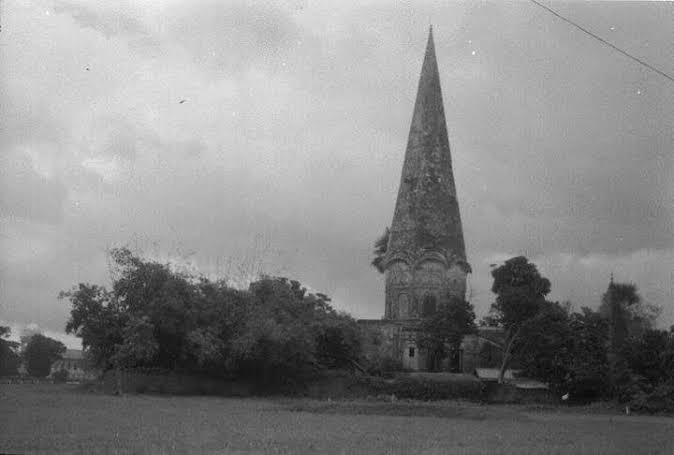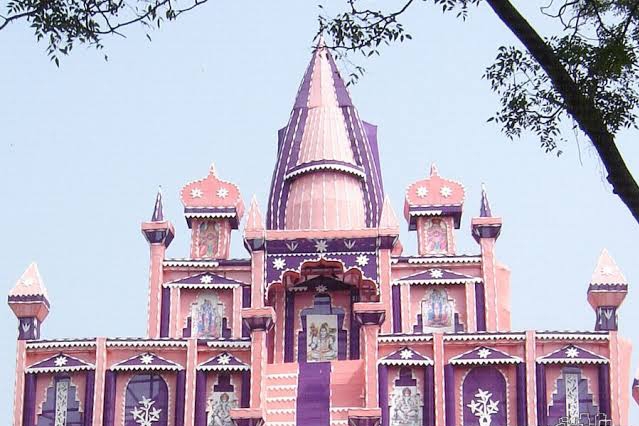The Ramna Kali Mandir (Bengali: রমনা কালী মন্দির) was a temple in Dhaka that was possibly built during the Mughal Era. It was also known as the “Ramna Kalibari”. The temple was dedicated to the Goddess Kali.
It was located beside the former Dhaka Racecourse, now Suhrawardy Udyan. The entire temple complex occupied almost 2.25 acres (9,100 m2) and was on the south side of Ramna Park, opposite the Dhaka Bangla Academy.
The temple was destroyed on March 27, 1971 by the Pakistani Army during the Bangladesh Liberation War. It was the site of a massacre of mostly Bengali Hindus.
History
In Nepalese folklore, the Ramna Kali Temple was founded by the devotees of the Goddess Kali. The devotees had come to Bengal from the Himalayas.
Although the temple had stood for centuries, it was largely developed in the early 20th century. The temple was developed under the patronage of Rani Bilashmoni Debi, wife of Rajendra Narayan (1882–1913). At this time, the temple was one of Dhaka’s tallest landmarks.
Design
The architectural design of the temple changed over the centuries in which it stood. In front of the temple was a large dighi (pool) which was a popular place for worshipers and visitors to swim. The temple has a tall shikhara (tower). Next to the temple was the Ma Anandamoyee Ashram (Bengali: মা আনন্দময়ী আশ্রম), a place of worship with a residential complex and facilities for washing.
The design of the temple is documented in pictures taken at Sheikh Mujibur Rahman’s address of 7 March 1971. This is likely the last time the temple was photographed by journalists or historians.
Demolition of Temple and Genocide by the Pakistan Army
On March 25, 1971, in the night, the Pakistan Army began its “Operation Searchlight” to oppose a Bengali nationalist movement in what was then East Pakistan. It led to a genocide and to the Bangladesh Liberation War.[2] Most of the targets of Operation Searchlight were young Hindu men, intellectuals, students and academics. Operation Searchlight focused on prominent Hindu sites including the Jagannath Hall (a hostel for Hindu students on the Dhaka University campus) and the Ramna Kali Mandir.
On March 27, 1971, the Pakistan Army entered the Ramna Kali Mandir complex and, within one hour, killed 85 people, almost all Hindus. Few Muslims who had sought refuge in the temple complex were also killed.
Until 2000, accounts of the demolition of the temple relied largely on the oral testimony of survivors of and witnesses. In 2000, Awami League, the governing political party, opened a public enquiry. In September 2000, the chairman Justice KM Sobhan, presented a preliminary report.
Only around 50 victims of the massacre have been identified; relatives of the other victims are either deceased or have left Bangladesh. A worldwide appeal has been made for any surviving relatives of the Ramna Kali Mandir massacre victims to contribute names of their deceased family members to be listed on a future memorial.
Confiscation by Bangladesh Government
The Kali temple was ruined. It was expected that it would be rebuilt or left as a memorial to those who died. However, the government of Bangladesh, led by Sheikh Mujibur Rahman made the temple an asset of the Department of Public Works. In 1972, the temple ruins were bulldozed. The land was given to the Dhaka Club, an exclusive recreation organization. The Ramna Kali Mandir Board, traditional owners of the temple, objected through the court but was unsuccessful.
Rebuilding
The Durga Mandir and the Radha Krishna Mandir are still present in the area of the Ramna Kali Mandir. Others are planned. The Government of India has pledged money for reconstruction efforts.
Source: Wikipedia & Google

